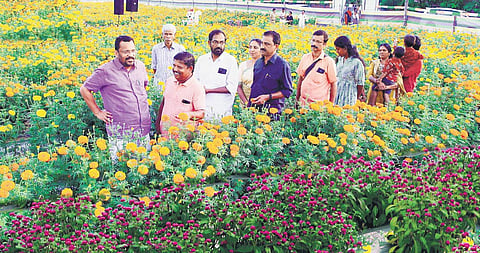

ALAPPUZHA/KANNUR/THIRUVANANTHAPURAM/KOLLAM/KOCHI : This is the season of Onam, and of floral carpets. But unlike in the past, Malayalis no longer depend on trucks arriving from neighbouring states to meet their flower needs. This ‘blooming’ revolution has been nearly four years in the making.
This year, Kerala is expected to harvest around 487 tonnes from 247.4 hectares of land under flower cultivation. According to the directorate of agriculture, the state is gradually moving towards achieving self-sufficiency in flower production, especially marigold.
What began as a project to grow at least one basket of flowers for Onam has caught on, in such a manner that many agriculture offices are now considering finding a market for their produce outside their own districts. “Production has increased manifold, with many farmers individually and as a collective growing flowers. We have been able to meet local requirements and soon will be expanding into neighbouring districts,” said Raihana K C, assistant principal agriculture officer, Ernakulam. Ernakulam currently ranks fifth among districts in the state in flower cultivation.
The leader of the pack, Alappuzha also posted a significant jump in output. According to Arun P K, district agriculture officer, production is up 80% from last year. “Farmers grow mostly marigold (both orange and yellow varieties) and vadamalli (globe amaranth) as they are in great demand locally. We expect to double the production next year,” he said. Flowers like marigold, sunflower, pichi poovu, arali or oleander and chrysanthemum are being grown in Alappuzha.
Kudumbashree also supports its members engaged in flower farming. Many government office premises have been converted into flower farms. Alappuzha municipality planted varieties along Alappuzha bypass and the harvest has been bountiful. Involving nearly 450 centres, Kannur’s ‘Onathinu Oru Kutta Poovu’ project is running at full throttle. “We hope to produce 100 tonnes of flowers this Onam season,” said P P Divya, district panchayat president. This is the third year of flower cultivation in the district.
“In the first year, we distributed five lakh saplings to farmers. Last year we doubled it to 10 lakh. This year, we have already made available 15 lakh saplings,” she said. The saplings are distributed through agriculture offices in various panchayats. “It has been a great year, and we have takers in the Kannur market. The only worry is that we are not able to produce flowers in large quantities on a daily basis,” said C K Santhosh, agricultural assistant of Aralam, Kannur.
In the capital district, desolate plots of land in grama panchayats have been transformed into beautiful flower meadows. Spread across six panchayats in Kattakkada, nearly 50 acres of marigold fields are in full bloom. “It all began with the Jala Samridhi project, which aimed at water conservation and replenishing the groundwater. We took up many initiatives, and one involved flower farming. Multiple departments are involved in the initiative,” said I B Satheesh, local MLA. Kurandivila and Mukkampalamoodu are some of the areas where farming is concentrated.
Privately owned barren land was leased out by panchayats. “Workers under the Mahatma Gandhi National Rural Employment Guarantee (MGNREGA) scheme helped prepare the land which was farmed by Kudumbashree members. We formed small groups and sourced funds from banks,” said Mallika T, president of Pallichal grama panchayat.
Looking beyond Onam
The horticulture mission has been striving for a prosperous outcome for marigold growers in Kollam. The department has set an ambitious target of 56,000 tonnes of marigold this Onam season. Anil Kumar, project director of the State Horticulture Mission, Kollam, emphasised that the demand for marigold is poised to remain strong, and prices will continue to favour farmers even beyond the Onam festival. “With numerous temple festivals on the horizon, we are betting on sustained demand and favourable market conditions for farmers. Yet, the challenge of a large-scale influx of flowers from Tamil Nadu persists,” he added.
Tourist attraction
Many flower plantations in the state have turned into tourist attractions, fascinating visitors from near and far. According to V P Suni, a farmer in Alappuzha, his two-acre plot has been attracting a lot of visitors since the flowers started to bloom. “I grow yellow and orange varieties of marigold and violet vadamalli. People have been coming to see the flowers in bloom. The sea of colour provides them with the perfect backdrop for photographs,” he said. “People in the state never had the opportunity to see flowers being cultivated on such a large scale. These were scenes exclusive to Tamil Nadu. Now we have them here, too. The flower fields are attracting vloggers, influencers and even wedding photographers.”